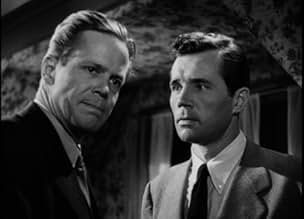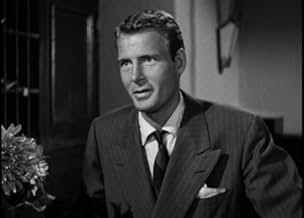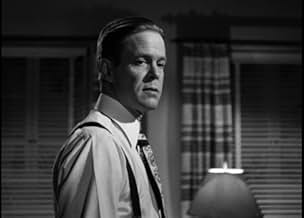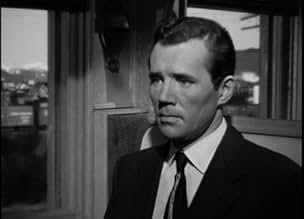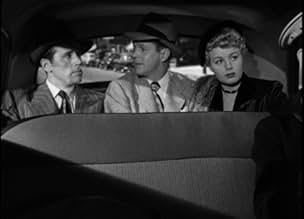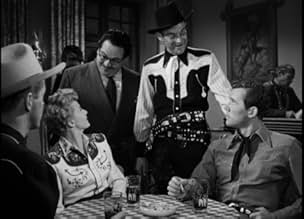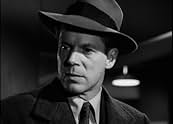Ajouter une intrigue dans votre langueUS Treasury agent George Morton persuades convicted criminal Johnny Evans to help him destroy a drug smuggling ring in exchange for early parole.US Treasury agent George Morton persuades convicted criminal Johnny Evans to help him destroy a drug smuggling ring in exchange for early parole.US Treasury agent George Morton persuades convicted criminal Johnny Evans to help him destroy a drug smuggling ring in exchange for early parole.
- Réalisation
- Scénario
- Casting principal
- Joey Hyatt
- (as Anthony Curtis)
- McCandle's Secretary
- (non crédité)
- Treasury Man
- (non crédité)
- Ranch Guest
- (non crédité)
- Pallbearer
- (non crédité)
- Nightclub Patron
- (non crédité)
- Courtroom Spectator
- (non crédité)
- Nightclub Patron
- (non crédité)
- Train Passenger
- (non crédité)
Avis à la une
To Castle's credit, he extracts very good performances from Duff, Winters, McIntire, Kelley and, especially, Dan Duryea, a con doing time who has sworn revenge against US Treasury agent Duff, but turns out to be more decent than imagined after seeing his wife killed as a consequence of consuming narcotics.
Soaring above the film's lofty acting standards, Duryea posts possibly his career-best show in a rare and surprising role as a seemingly inveterate baddie with a decent streak which ultimately redeems and finds him love and happiness. The revenge he warns Duff about turns out to be the wonderful woman who recognizes his worth in the end.
Winters and McIntire also deliver superb performances, the latter as the cold and calculating master villain. Interesting to note that the following year, 1950, Duryea, Winters and McIntire would re-assemble in one of the greatest Westerns ever, WINCHESTER '73.
As would a very young Anthony (Tony) Curtis, who in JOHNNY gets a small and wordless but crucial part as a baby-faced good for nothing... other than killing.
Cinematography deserves considerable praise throughout, the highlights being the early scenes at a dockyard, the apparent alacrity of all in a restaurant/dancing room, and the hangar at the end.
Chases and other action sequences are crackingly well staged, including the shootouts and, above all, the decisive plane-police car crash.
True, the script does not rise above some predictability, but then it is based on true FBI reports, and you know that good will win over evil. Thank God!
The routine story is boosted by a good cast and some nice production touches. That opening shootout grabs us right away, along with the moody location shots of San Francisco, and later, in and around Tucson. The film was made at a time when movies were hitting the streets instead of the sound stages, so it's a good chance to catch styles and relics, circa 1949.
Surprise, surprise, veteran bad guy Duryea actually gets a semi-sympathetic role and only has to snarl once. And catch the unforgettable Shelley Winters, just starting her whiny isn't-she- cheap act. Between them, they lend real color to the production, along with a sneakily jovial John McIntire as the dude ranch host.
Some film buffs may not be aware of director William Castle's career before becoming a notorious schlockmeister with gimmicky teenage films like 13 Ghosts (1960) or The Tingler (1960). But he had a very respectable career at RKO with the brilliantly offbeat The Whistler series of the late '40's before coming over to Universal for this crime drama.
There're a number of good touches here. Catch a young Tony Curtis as the mute hit-man, a role made all the more effective by his pretty-boy good looks. Also, what a great way to heighten suspense by handing off that life-or-death message to a possibly non-English speaker, or by filming the climactic scene at an actual border-crossing with its rows of backed-up cars.
No, a programmer like this won't win any awards, but it's another example of how energetic movie-making was during its studio period.
There is an international drug ring running from Mexico all the way to Vancouver. The federal authorities have some leads...but not much. So, to help them infiltrate this mob, George (Duff) arranges to have Johnny Evans (Duryea) released early from prison. The problem is George isn't very sure how far he can trust his new partner and they go undercover at a dude ranch outside of Tucsan, Arizona. Things get complicated when Johnny brings along a dame he feels sorry for (Shelley Winters), though having her along might easily jeopardize everything.
The film is mostly unremarkable but enjoyable. However, the movie really had a terrific ending--and this alone help elevate the movie above the ordinary. Well worth seeing.
This is a quick moving film that also stars a young Tony Curtis as a mute bodyguard/hit-man. All the cast do well with Dan Duryea being especially likable as a criminal who doesn't like cops. I have to admire his underhand ways as demonstrated when Duff doesn't allow him to go to the bar to meet Shelley Winters (Terry). Duryea takes advantage of a visit by McIntire to pick up his jacket and let Duff know that he's going to the bar by just walking out of the room leaving Duff powerless to do or say anything infront of a guest. We then see him sitting with Winters and enjoying himself. Good for him – nice move, Duryea! He plays by his own rules and keeps the viewer guessing as to whether or not he is going to betray Duff.
It's filmed on location in San Francisco and Arizona and has an ending that had me cheering!
Le saviez-vous
- AnecdotesThe old plane seen outside the airport hangar at the end, was a captured Japanese Nakajima B5N ("Kate") Torpedo Bomber from World War II. It had been shot down at the attack on Pearl Harbor on December 7, 1941.
The plane had been sent to Arizona and stored at the Davis-Monthan Air Force Base, in Tucson, Arizona for warfare aeronautical studies during the beginning of the war. It was lent to the movie producers.
- GaffesNear the end, when Morton and the plane are on a collision course, we see through Morton's car window the plane has lifted off, and is about to clear the car, but when they cut to the crash, the plane hasn't left the ground.
- Citations
Terry Stewart: [in Canada, while Johnny and Terry are dancing] Where're you from, Johnny?
Johnny Evans: The States - California.
Terry Stewart: Ohh, California... you mean there's still a place where it's warm and got palm trees... and you can lie out in that lovely hot sun all the year round...
Johnny Evans: I guess so. You know California?
Terry Stewart: Uh-uh. Ah, I was brought up in Tucson - Arizona. Wish I'd never left it. Been in this dump for 2 years. The only time I've ever been warm was once I went to sleep with a cigarette and I set the bed on fire.
- Crédits fous[prologue] In their never-ending task of law enforcement, the officers of the Bureau of Narcotics and the Bureau of Customs of the United States Treasury fight many battles such as the one you are about to see. Their successes are a tribute to their skill, intelligence and courage. To their fearless officers we respectfully dedicate this picture.
- ConnexionsReferenced in Johnny Staccato: An Angry Young Man (1960)
Meilleurs choix
- How long is Johnny Stool Pigeon?Alimenté par Alexa
Détails
- Date de sortie
- Pays d’origine
- Sites officiels
- Langues
- Aussi connu sous le nom de
- Johnny Stool Pigeon
- Lieux de tournage
- Société de production
- Voir plus de crédits d'entreprise sur IMDbPro
- Durée
- 1h 16min(76 min)
- Couleur
- Rapport de forme
- 1.37 : 1


